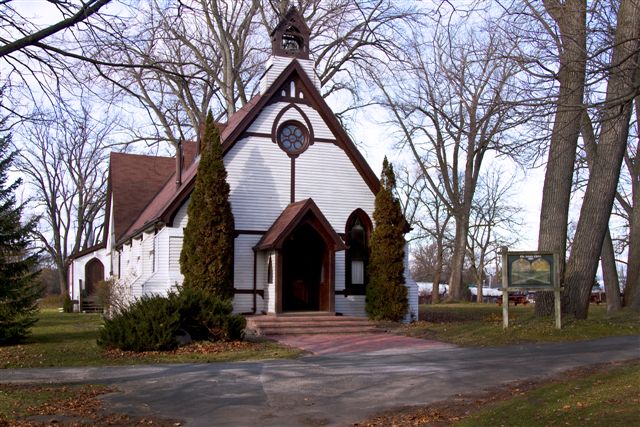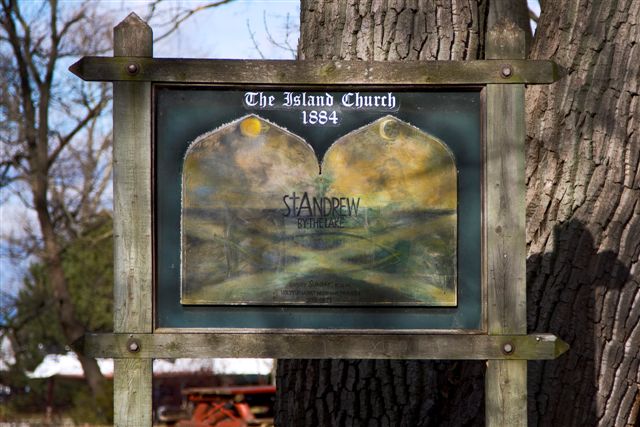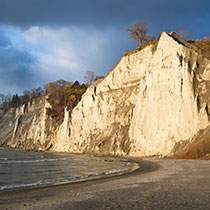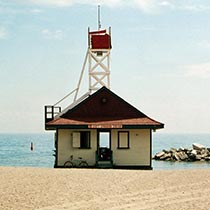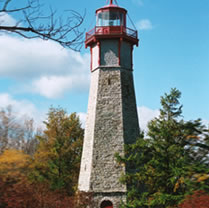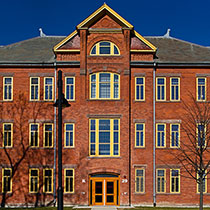In the mid twentieth century, the elimination of all Toronto Island homes was mandated to make way for a massive city park. During the 1950s and 1960s, the majority of residences were bulldozed into the earth, along with the community’s eclectic “main street” — Manitou Road on Centre Island (full-time residents still reside on Ward’s and Algonquin Island today). What is little recognized is that the humble abodes of many Islanders were not the only collateral damage to the implementation of the “uber-park”; Toronto’s built heritage also suffered a significant blow as the wrecking ball tore into the former elegant summer homes and mansions of Toronto’s leading families, along with, to name a few, Ward’s Hotel, the Pierson Hotel, and English’s Boathouse – all flattened in the name of “progress”.
Miraculously, the Anglican church St. Andrew-by-the-Lake escaped the forces of destruction, and remains not only a fully operating church, but a vibrant focal point for the life of the community. In a sense, its story is intertwined with the story of the Island itself. In the spirit of the season, I thought a short excerpt from Along the Shore might be appropriate.
Robertson’s Landmarks of Toronto describes services held at the church in the late nineteenth century: “The first thing noticeable was the unconventional style of dress characterizing many persons there . . . This variety of dress, taken with the plainly furnished chapel, the open windows, through which the breezes came laden with vigour and health, the sound of the surf on the shore and the gay laughter of little children playing on the sand made the room pleasant, cool, airy and bright.”
This description dates from some fifteen years after the celebration of the first services at St. Andrew, which took place on July 27, 1884. At that time the church was located on the south shore of Centre Island, at the corner of what would in later years become Cherokee and Lakeshore Avenues. The church owed its inception to an Island summer resident, Bishop Arthur Sweatman (later Archbishop of Toronto and then Primate of Canada). It was built to meet the needs of a growing summer community that included the prominent Gooderham and Massey families, who were leading members of the congregation at St. Andrew.
Designed by architect Arthur Denison, who summered on the Island at that time, St. Andrew was a charming semi-gothic variation on the stick style of construction then prevalent on the Island. It was also conveniently located next door to the summer residence of Bishop Sweatman, which was also conceived by Denison and aptly named Happy-Go-Lucky.
Although modest and in keeping with its Island surroundings, the interior of Saint Andrew was then and still is now by no means commonplace. The original walls and vaulted ceiling remain clad in tongue and groove fir. Several windows in the chancel were made in 1885 by the renowned McCausland studio in Toronto, while another memorial window by N.T. Lyon pays tribute to the remarkable contribution that Islanders made during the First World War.
During the dark years of the late 1950s, when the communities of Hanlan’s Point and Centre Island were destroyed to make way for an Island park, St. Andrew was sold to the city but leased back to the Archdiocese for an indefinite period. In 1959-60, the church was moved to its present location on Centre Island, closer to Ward’s Island, along with its Roman Catholic counterpart, St. Rita’s. By 1974 the congregation had dwindled to about fifteen families and in 1979 the City of Toronto condemned St. Andrew, just four years after the Parish had celebrated its centennial. With a six-foot-high wire fence put up around it and the few remaining parishioners facing eviction, it seemed that the church was destined to be reduced to rubble, like so many of the other historic Island properties that had gone before it.
However, the forces of desecration that passed themselves off as “progress” were not to have the last word. In the first place, they had not reckoned with the determination of the Islanders themselves. Using wire cutters retrieved from one of the nearby homes, parishioners John Fowlie and Liz Amer cut through a section of the fence shortly after the church was condemned. The congregation went in and the Sunday services continued despite the eviction notice. The community continued to use its church through the years of uncertainty that followed. Eventually, in 1984, St Andrew was saved by an agreement between the city and the Anglican Archdiocese of Toronto. Reverend Michael Marshall, the present incumbent of St. Andrew and himself a former Island resident explains that the remaining Islanders never lost sight of the fact that St Andrew was “part of their heritage and legacy. They recognized the need to maintain their use of it, so it didn’t become a pawn in the struggle between the forces who would destroy the Island community and those who would save it.”
Sadly, St. Rita’s was indeed demolished, while its remaining parishioners attended separate worship services at St. Andrew. Items salvaged from St. Rita’s, such as its wooden oak pews, and the Stations of the Cross that now adorn St. Andrew’s dark paneled walls, all added to the richness of a setting that had developed there for more than a century. St Andrew now represented more than just itself. Perhaps unwittingly, this little church had become a symbol for a good and simple way of living and a repository for the relics of past Island life.
On Christmas Eve, Torontonians can still leave the city, cross the water, and walk along a quiet road to a tiny country church no more than minutes from the metropolis. From it emanates the spirit of the Island, past and present; it houses the memories of an earlier time, and is a testament to the enduring life of the community.
Along the Shore © Copyright Jane Fairburn, 2012.



